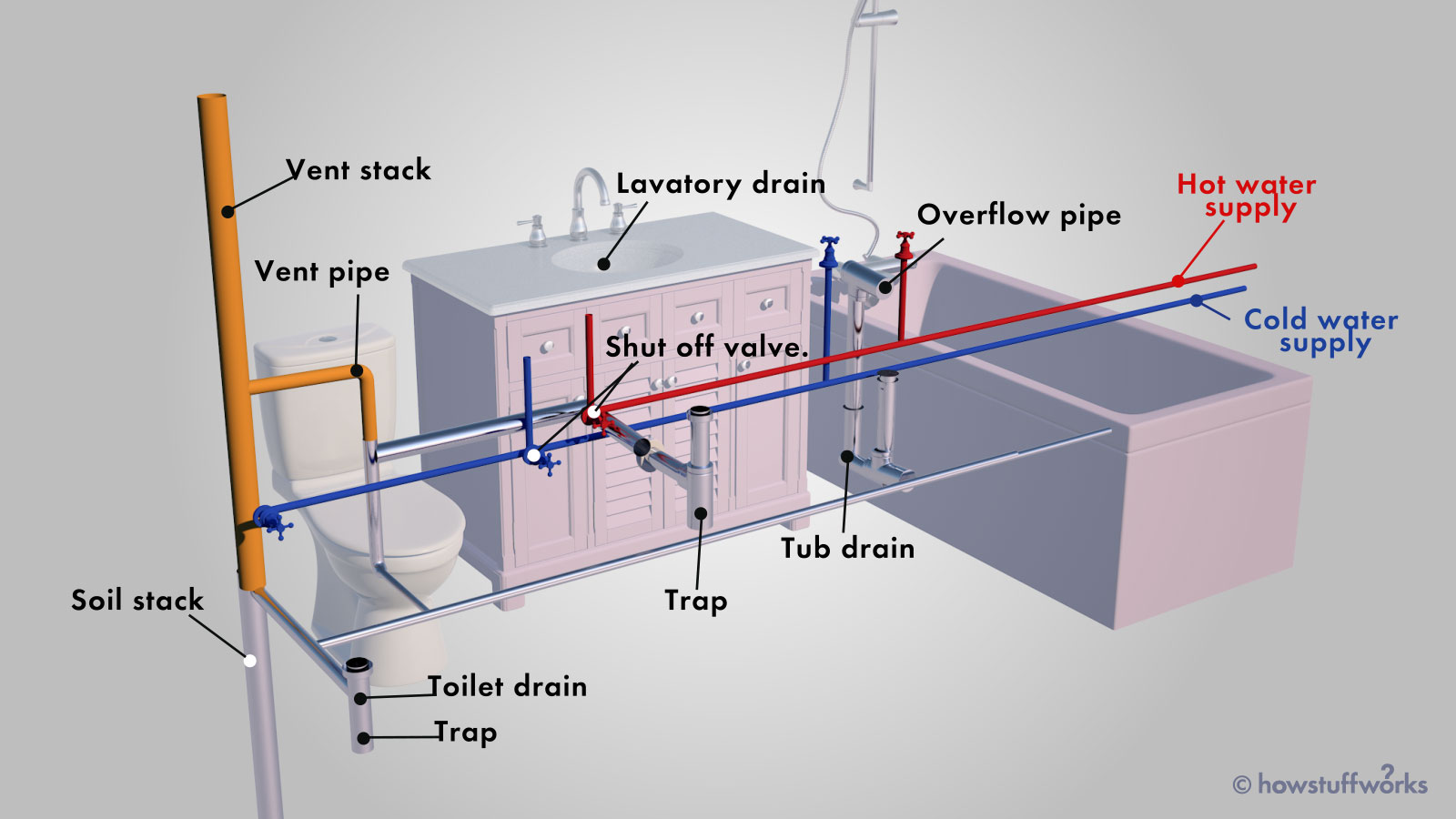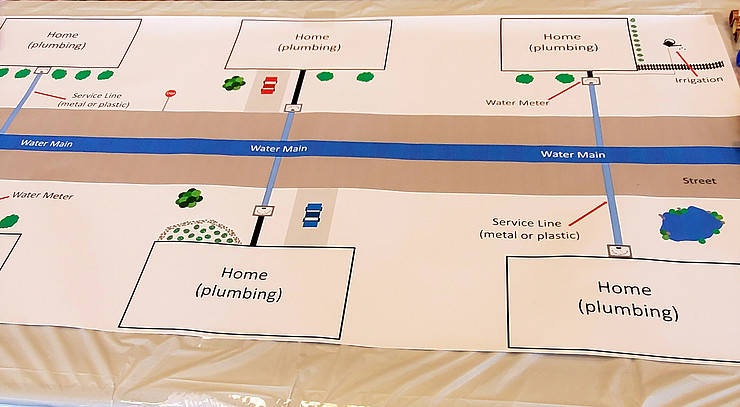The Basics to Your Home's Plumbing System Anatomy
The Basics to Your Home's Plumbing System Anatomy
Blog Article
They are making several great annotation related to The Inner Workings of Your Home's Plumbing in general in the article below.

Understanding how your home's pipes system functions is essential for every single home owner. From supplying tidy water for alcohol consumption, food preparation, and bathing to safely eliminating wastewater, a properly maintained pipes system is important for your family members's wellness and comfort. In this thorough guide, we'll discover the detailed network that comprises your home's pipes and deal ideas on upkeep, upgrades, and handling usual concerns.
Introduction
Your home's plumbing system is greater than just a network of pipes; it's a complex system that guarantees you have accessibility to clean water and reliable wastewater removal. Recognizing its elements and exactly how they work together can help you protect against costly fixings and make sure every little thing runs efficiently.
Standard Elements of a Plumbing System
Pipes and Tubes
At the heart of your plumbing system are the pipes and tubing that lug water throughout your home. These can be constructed from different products such as copper, PVC, or PEX, each with its advantages in regards to resilience and cost-effectiveness.
Components: Sinks, Toilets, Showers, and so on.
Components like sinks, bathrooms, showers, and bathtubs are where water is made use of in your house. Understanding exactly how these fixtures attach to the pipes system helps in diagnosing problems and planning upgrades.
Shutoffs and Shut-off Points
Shutoffs manage the circulation of water in your pipes system. Shut-off valves are crucial throughout emergencies or when you need to make repairs, permitting you to isolate parts of the system without interfering with water flow to the entire residence.
Supply Of Water System
Main Water Line
The main water line links your home to the municipal water or a personal well. It's where water enters your home and is distributed to various components.
Water Meter and Stress Regulatory Authority
The water meter steps your water use, while a pressure regulator makes sure that water flows at a risk-free stress throughout your home's plumbing system, avoiding damages to pipes and components.
Cold Water vs. Hot Water Lines
Understanding the difference in between cold water lines, which supply water directly from the major, and hot water lines, which bring heated water from the water heater, aids in repairing and planning for upgrades.
Drain System
Drain Pipes Water Lines and Traps
Drain pipes carry wastewater far from sinks, showers, and toilets to the sewer or septic system. Traps avoid sewage system gases from entering your home and also catch particles that could create obstructions.
Air flow Pipelines
Air flow pipes allow air into the drain system, stopping suction that can reduce drainage and cause traps to vacant. Appropriate air flow is necessary for preserving the integrity of your pipes system.
Relevance of Proper Drainage
Ensuring appropriate drainage avoids back-ups and water damage. Frequently cleansing drains pipes and keeping catches can protect against costly repair work and prolong the life of your pipes system.
Water Heater
Sorts Of Water Heaters
Hot water heater can be tankless or standard tank-style. Tankless heaters warmth water as needed, while tanks keep heated water for prompt use.
Exactly How Water Heaters Link to the Pipes System
Comprehending exactly how hot water heater link to both the cold water supply and warm water distribution lines aids in diagnosing problems like insufficient warm water or leakages.
Maintenance Tips for Water Heaters
Routinely flushing your water heater to get rid of debris, inspecting the temperature setups, and inspecting for leaks can prolong its life expectancy and boost power efficiency.
Typical Pipes Issues
Leakages and Their Reasons
Leakages can occur as a result of aging pipelines, loosened fittings, or high water stress. Attending to leaks promptly stops water damages and mold and mildew development.
Blockages and Blockages
Obstructions in drains pipes and commodes are usually triggered by purging non-flushable products or an accumulation of grease and hair. Using drain screens and bearing in mind what drops your drains can stop blockages.
Indicators of Plumbing Troubles to Expect
Low water stress, sluggish drains pipes, foul odors, or uncommonly high water costs are signs of prospective pipes troubles that need to be dealt with quickly.
Plumbing Maintenance Tips
Regular Inspections and Checks
Arrange yearly plumbing assessments to capture issues early. Look for indications of leakages, corrosion, or mineral buildup in faucets and showerheads.
DIY Maintenance Tasks
Basic jobs like cleansing faucet aerators, looking for commode leaks utilizing dye tablet computers, or shielding revealed pipes in chilly climates can prevent major pipes issues.
When to Call an Expert Plumbing
Know when a pipes concern calls for specialist knowledge. Attempting complicated repairs without appropriate knowledge can lead to even more damages and greater repair prices.
Updating Your Plumbing System
Reasons for Upgrading
Upgrading to water-efficient components or replacing old pipelines can boost water top quality, lower water expenses, and enhance the worth of your home.
Modern Plumbing Technologies and Their Advantages
Explore innovations like clever leakage detectors, water-saving commodes, and energy-efficient water heaters that can conserve money and lower environmental effect.
Expense Considerations and ROI
Determine the upfront expenses versus lasting savings when considering plumbing upgrades. Numerous upgrades spend for themselves through minimized utility costs and fewer repairs.
Environmental Influence and Preservation
Water-Saving Fixtures and Home Appliances
Mounting low-flow taps, showerheads, and commodes can dramatically reduce water use without sacrificing performance.
Tips for Reducing Water Usage
Easy behaviors like fixing leakages immediately, taking much shorter showers, and running complete loads of laundry and recipes can conserve water and lower your energy expenses.
Eco-Friendly Pipes Options
Consider sustainable pipes products like bamboo for floor covering, which is durable and environment-friendly, or recycled glass for countertops.
Emergency situation Readiness
Steps to Take Throughout a Pipes Emergency
Know where your shut-off valves lie and exactly how to turn off the supply of water in case of a ruptured pipe or significant leak.
Importance of Having Emergency Contacts Helpful
Maintain contact details for local plumbings or emergency situation solutions easily available for quick response throughout a plumbing dilemma.
DIY Emergency Fixes (When Suitable).
Temporary repairs like using air duct tape to spot a leaking pipe or positioning a pail under a dripping faucet can reduce damage until a professional plumber arrives.
Conclusion.
Recognizing the makeup of your home's plumbing system equips you to maintain it efficiently, conserving time and money on repairs. By following normal maintenance regimens and staying informed concerning modern pipes modern technologies, you can ensure your pipes system runs efficiently for many years ahead.
Exploring Your Homes Plumbing Anatomy
Water Supply System
Main Water Line: This is where water enters your home from the municipal supply or a private well.
Water Meter: Typically located near where the main water line enters the property, it measures the amount of water used.
Shutoff Valve: It s crucial to know where this is in case of emergencies. It allows you to turn off the water supply to the entire house.
Pipes and Fittings: These distribute water throughout your home. Materials can include copper, PVC, or PEX.
Drain-Waste-Vent (DWV) System
Drains: Located in sinks, showers, and tubs, these carry wastewater away.
Traps: U-shaped pipes under sinks that hold standing water, blocking sewer gases from entering the home.
Vents: Pipes that lead from the DWV system to the outside, preventing vacuum formation and allowing gases to escape.
Sewer Line: Carries all wastewater from the home to the municipal sewer system or a septic tank.
Fixtures and Appliances
Sinks, Toilets, and Showers
Dishwashers and Washing Machines
Water Heaters
Maintenance Tips
Regularly check for leaks in exposed pipes and around fixtures.
Inspect the water heater annually for signs of wear.
Clean drains and traps to prevent clogs and odors.
Know how to shut off water to individual fixtures.
When to Call a Professional
Major leaks or burst pipes
Installation of new pipes or fixtures
Septic tank issues
Remodeling projects that involve plumbing changes
Conclusion
Understanding the anatomy of your home's plumbing is key to maintaining a functional and efficient system. Regular checks and knowing when to call in the experts can save you time, money, and stress.
https://www.mavyn.com/blog/exploring-your-homes-plumbing-anatomy

Exploring Your Homes Plumbing Anatomy
Water Supply System
Drain-Waste-Vent (DWV) System
Fixtures and Appliances
Maintenance Tips
When to Call a Professional
Conclusion
Understanding the anatomy of your home's plumbing is key to maintaining a functional and efficient system. Regular checks and knowing when to call in the experts can save you time, money, and stress.
https://www.mavyn.com/blog/exploring-your-homes-plumbing-anatomy
We are very interested by Understanding Your Home's Plumbing Anatomy and I really hope you enjoyed reading my page. If you please take the opportunity to promote this post if you enjoyed it. We enjoy your readership.
Or Book Technician Here Report this page